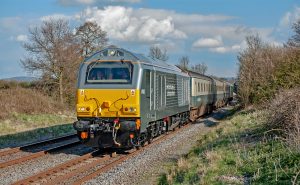Wrexham & Shropshire, a Photographic Retrospective, by Geoff Plumb, 3rd May 2022
3rd May 2022 Meeting
Our scheduled speaker for May had to cancel at the last moment due to Covid issues and our Branch Chairman Geoff Plumb stepped into the breach by saying: “me, me, me, me” the loudest for an excellent show of ‘The Wrexham, Shropshire & Marylebone Railway – A Photographic Retrospective’.
We started off with GWR ‘Castle’ Class 4-6-0 No. 7029 Clun Castle passing the site of Ilmer Halt between Princes Risborough and Haddenham with the 16:15 train from London Paddington to Banbury, on Friday 11th June 1965. This was the last regularly steam-hauled train from Paddington, and this was its final run.
This was to be on the route of the railway. Wrexham & Shropshire (officially Wrexham Shropshire & Marylebone Railway Company Limited, Welsh: Cwmni Rheilffordd Wrecsam, Swydd Amwythig a Marylebone) was an open access operator operating passenger rail services between Wrexham and London Marylebone from April 2008 until January 2011.
They had 5 Class 67 Locomotives, 16 Mk 3 Carriages and 5 Driving Van Trailers.
Financial support for the venture was forthcoming from the Welsh Assembly. New facilities were opened at Wrexham General, while a refurbishment programme of the Mark 3 carriages resulted in higher quality rolling stock being introduced from September 2009.
In 2009, it became clear that the service was attracting a lower than anticipated number of passengers, an outcome that Wrexham & Shropshire attributed to a wider economic downturn. The number of trains operated was decreased from a peak of five per day to three per weekday by December 2010. A rival service launched by Virgin Trains between London and Wrexham via Chester had also been launched in October 2008; other operators also had ambitions to launch direct trains between London and Shrewsbury. During January 2011, it was announced that there was no prospect of the service ever becoming profitable; on 28 January 2011, Wrexham & Shropshire ceased all operations.
From Wrexham General services ran via Ruabon, Chirk, Gobowen, Shrewsbury, Wellington, Telford Central, Cosford and Wolverhampton to Tame Bridge Parkway. From here services would proceed to Banbury and London Marylebone either via Stechford, Birmingham International and Coventry, or via Birmingham New Street and Solihull.

67013 and 67014 had only arrived in Banbury the day before from Crewe, having just been outshopped from Toton in the new silver livery of the Wrexham & Shropshire Railway. The two locos are topping and tailing 5Z16 for the first time, the down training run from Marylebone, 16:10 to Banbury, on the afternoon of Tuesday 8th April 2008, running slightly early at 17:01½ as they pass Kingsey, just south of Haddenham. Once again, the formation includes a Sleeping-Car! Image Credit: Geoff Plumb
Because of a Moderation of Competition clause inserted into Virgin Trains' Track Access Contract with Network Rail by the government, Wrexham & Shropshire were not able to service a number of West Coast Main Line stations. Wrexham & Shropshire's Track Access Contract did not allow it to call at Birmingham New Street or Coventry, although the contract did allow it to call at Wolverhampton and Birmingham International to pick up only on northbound services and set down only on southbound services, although Wrexham & Shropshire elected not to serve the latter.
Likewise to protect Chiltern Railways from revenue abstraction (even though both entities were owned by the same parent company, DB Regio), northbound services could only pick up and southbound services set down at Banbury. From December 2009, the Banbury restrictions were lifted, and services also called at Leamington Spa. The Leamington Spa stops were removed in May 2010, after the Department for Transport found that revenue had been abstracted from Chiltern Railways.
During weekend engineering works, Wrexham & Shropshire services were frequently diverted. When the Wrexham to Shrewsbury line was closed services operated from Wrexham General to Shrewsbury via Chester and Crewe. When the Shrewsbury to Wolverhampton line was closed services reversed at Shrewsbury before reversing again at Crewe and proceeding via Stafford to Wolverhampton. When the line south of Birmingham was closed, services operated via the West Coast Main Line, Willesden Junction, Acton Wells Junction and Ealing Broadway to South Ruislip before reversing to reach Marylebone. When the South Ruislip to Marylebone line was closed services would be diverted to London Paddington.
Geoff showed photographs of the trains in many different locations, through livery changes, and locos the ‘wrong way’ round so the colour scheme didn’t match up.
He also showed earlier snaps of the last loco hauled train back in January 1992 which was an up service in the morning and down at night from Banbury to Paddington & return.
Geoff developed good relationships with many of the officials and drivers at WSMR which enabled him to have cab rides and visits by invitation, allowing lots of different shots which would otherwise have been unattainable, especially the unusual routeing that happened some weekends, and the final scenes at Wrexham on the arrival of the very last train.
As usual with Geoff there were many excellent photos, and it was such a shame when the company went bust. Also a shame that the total attendance including Geoff was only 14, the show certainly deserved more!
Rob Davidson, Watford Branch Secretary
